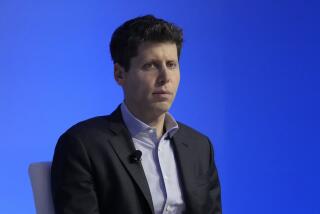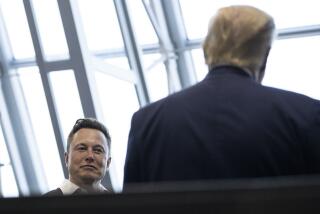U.S. Venture Funding Reaches 18-Month High
- Share via
After the Sept. 11 terrorist attacks, Alan Purwin’s helicopter company was virtually grounded, a financial blow that nearly broke him.
It was a real wake-up call about the hazards of owning all of your own business. So when a local investor approached him last year with an offer to buy a slice of Helinet Aviation Services, Purwin was eager to listen. He ended up selling a 25% stake to Santa Monica-based Bison Capital Management in November, for $20.5 million.
“Insulating my family and taking some of my chips off the table just made sense,” said the 42-year-old Purwin, who owns 41 aircraft that he maintains and flies for corporate chieftains, TV news crews, medical transport outfits and moviemakers. (He even has a cameo in “The Italian Job,” piloting the chopper in the scene where Edward Norton chases a trio of Cooper Minis through downtown Los Angeles.)
The timing was just right, for Helinet and Bison and hundreds of others. Venture capital investing nationwide climbed to $4.9 billion in the fourth quarter, according to a Money Tree survey to be issued today, up 12% from $4.3 billion in the third quarter and the highest tally in a year and a half.
What’s more, 13 venture-backed companies sold stock for the first time through initial public offerings in the fourth quarter -- the most in three years -- according to a separate report issued Monday by Ernst & Young and data tracker Venture One.
On the heels of a third quarter in which the U.S. economy grew at its fastest clip in 20 years, venture capitalists are relieved to see signs of life in the long-moribund market for IPOs, a trend that could signal an easier path to profitable exits for the investors.
“Venture capitalists see that there is now liquidity,” said Randy Churchill, director of business development for PricewaterhouseCoopers’ technology practice in L.A. “They’re saying, ‘It’s time to fund again.’ ”
Churchill said PricewaterhouseCoopers had been swamped with requests for updated audits on companies already in venture capitalists’ portfolios. (PricewaterhouseCoopers collected the Money Tree survey data along with Thomson Venture Economics and the National Venture Economics Assn.)
“They tell us they need them right away,” he said. “They’re getting these companies teed up for an IPO or acquisition in the next two or three quarters.”
Venture capital investors offer a key source of capital for private companies, purchasing stakes and helping to nurture entrepreneurs with the hope of cashing in upon an eventual IPO or acquisition by a larger rival.
For Bison, the attraction of Helinet, based in Van Nuys, was simple: “We look for a good company that’s trying to grow,” said Jim Hunt, Bison Capital’s managing partner. And in fact, he said, he expected Helinet’s revenue to climb to more than $30 million in 2004 from $21 million last year.
Even with the fourth-quarter funding increase, deal volume was a far cry from venture capital’s so-called bubble days. Activity peaked at $28.6 billion in the first quarter of 2000.
But investors and analysts say the market has stabilized and returned to a healthy trend.
In Southern California, which represents about one-tenth of the U.S. venture market, financing slipped 6% to $420 million in the fourth quarter, from $448 million in the third quarter, but analysts attributed that to “timing issues,” as a crush of biomedical deals were finalized in two previous quarters.
The Silicon Valley area, the nation’s No. 1 region for venture investing, saw deal volume surge 20% to $1.6 billion in the fourth quarter, paced by increases in most technology industries. Churchill said the area’s diverse base of tech firms and enthusiasm over the improved IPO market had contributed to the increase.
Nationwide, biotech maintained its momentum as the most popular industry, with $1.1 billion of investment. It was the top category for the second straight quarter and for only the second time in eight years, outpacing software, which accounted for $978 million.
As Southern California’s deal flow illustrates, however, a diverse group of businesses attracted new cash.
Sherman Oaks-based Radiovisa Corp. -- which took in the Southland’s largest investment last quarter at $31.5 million -- used the funding to start its 24-hour network of Spanish talk radio. Radiovisa bought L.A.’s KPLS and turned it into KMEX-830 AM, the syndicated network’s flagship, said Ray De La Garza, chief operating officer.
Along with Radiovisa and Helinet, other hefty financings included: Brea-based mortgage originator Residential Mortgage Assistance Enterprise, which took in $25 million; Westlake Village-based Strix Systems Inc., a wireless communications equipment maker that got $20 million; and two San Diego companies, liver drug producer Metabasis Therapeutics Inc., which got $24.9 million, and digital copyright technology developer Verance Inc., which got $22 million.
In Van Nuys, Purwin said he was confident Bison’s investment would pay off. He co-founded Helinet in 1987, when he and his former partner “leveraged ourselves silly” to buy a 12-year-old Bell Longranger for $400,000. Now he hopes to expand the business by supplying choppers with high-definition photography equipment that would appeal to film studios and homeland-security agencies.
Meanwhile, he’s not neglecting the basic point A to point B business. On Monday, he started flying Dennis Miller from Santa Barbara to his new TV talk show in Burbank.
“I hope that show is a big success,” Purwin said, “and he needs my services for another 20 years.”






